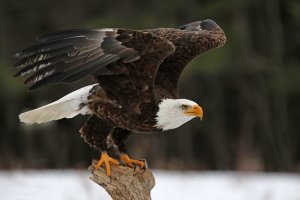Bird of the Week: Bald Eagle
 Happy Independence Day from your Metroparks! This week’s Bird of the Week feature is the Bald Eagle. The Bald Eagle was chosen as the symbol of the United States in 1782 for its strength, longevity and majestic appearance, which represents the strength and freedom of our nation. Benjamin Franklin argued against our nation’s symbol, because the eagle steals food from more vulnerable birds- not exactly majestic or honorable. The Bald Eagle can be easily identified by its stark white head and tail and dark brown body and can be found soaring alone with flat wings searching for carrion, a dead animal, to steal from smaller animals. Although they are excellent fishers and skilled hunters, they prefer to let other animals do the work for them! They build massive nests- 5 to 6 feet across and 2 to 4 feet deep- in tall trees near a large body of water and will use the same nest year after year. Bald Eagles pair for life and typically raise 1-3 eaglets each year.
Happy Independence Day from your Metroparks! This week’s Bird of the Week feature is the Bald Eagle. The Bald Eagle was chosen as the symbol of the United States in 1782 for its strength, longevity and majestic appearance, which represents the strength and freedom of our nation. Benjamin Franklin argued against our nation’s symbol, because the eagle steals food from more vulnerable birds- not exactly majestic or honorable. The Bald Eagle can be easily identified by its stark white head and tail and dark brown body and can be found soaring alone with flat wings searching for carrion, a dead animal, to steal from smaller animals. Although they are excellent fishers and skilled hunters, they prefer to let other animals do the work for them! They build massive nests- 5 to 6 feet across and 2 to 4 feet deep- in tall trees near a large body of water and will use the same nest year after year. Bald Eagles pair for life and typically raise 1-3 eaglets each year.
Now a fairly common sight across most of the United States and Canada, the Bald Eagle was in danger of extinction only a few decades ago due to habitat loss, illegal hunting, and the use of the pesticide DDT. DDT runoff into lakes and rivers contaminated fish that were consumed by eagles, which thinned their eggshells and led to widespread nest failures. Bald Eagle conservation gained ground in 1972 when DDT was banned in the US and eagles were protected under the Migratory Bird Treaty Act. Once considered an endangered species, the Bald Eagle population continues to increase and is now listed as a species of Least Concern due to continued conservation efforts and federal protection.
Visit https://www.audubon.org/field-guide/bird/bald-eagle to learn more about the species. Check out the Cleveland Metroparks’ livestream nest cam at https://www.clevelandmetroparks.com/about/conservation/natural-resources/bald-eagle-nest-livestream. Bald Eagles nest in a few of your Metroparks, so be on the lookout the next time you visit. Remember, these birds are federally protected, so please watch them from a distance.
